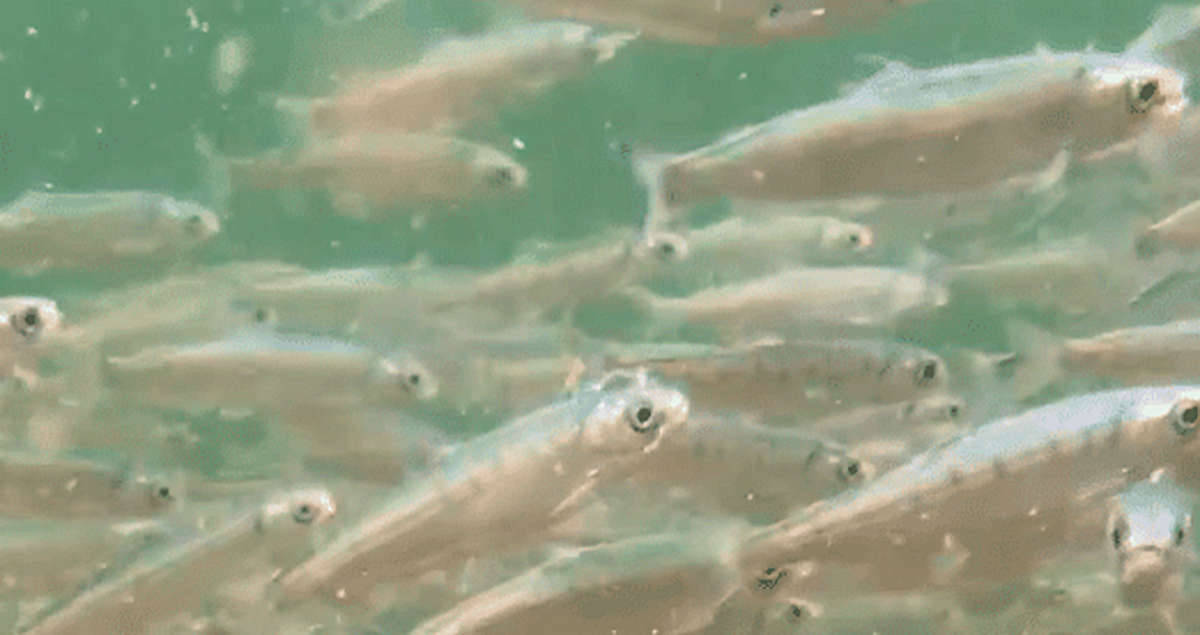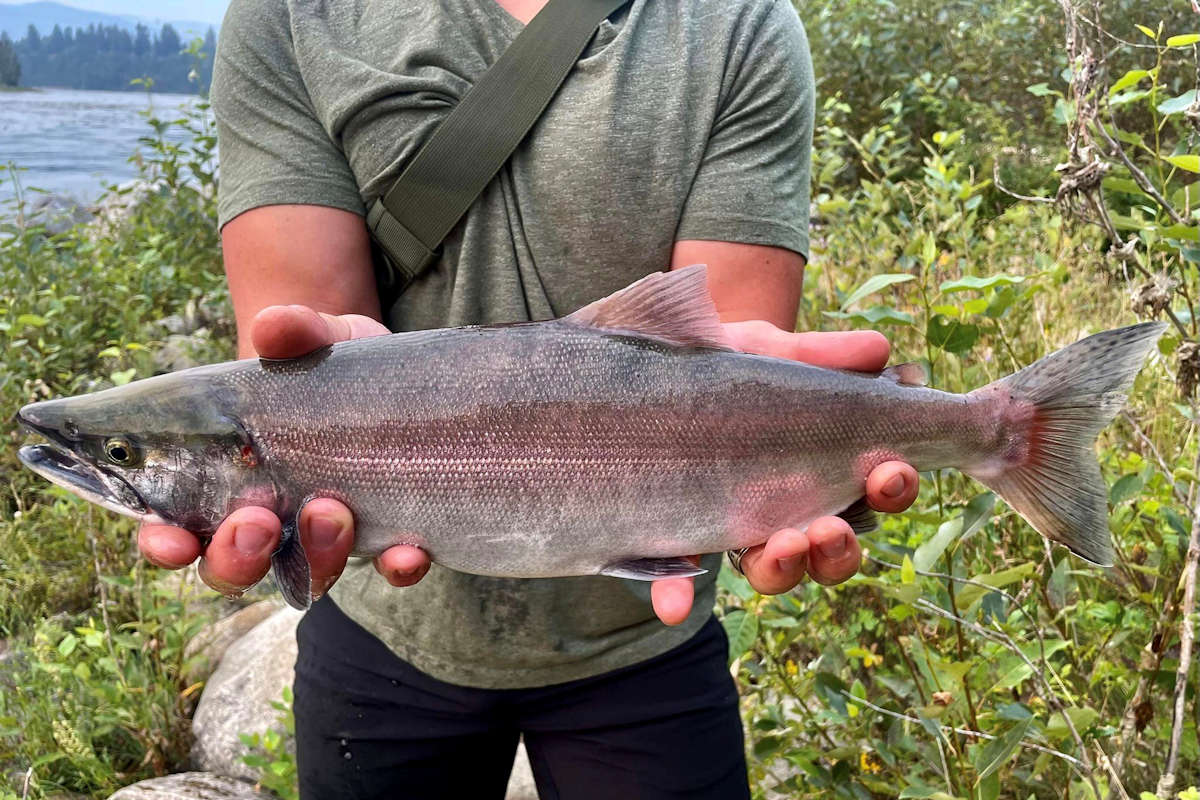Sockeye Salmon Photo Credit: Scott Beauchamp
The section of the Columbia River north of the U.S. border from Trail to Castlegar has not seen native migratory salmon in its waters since the construction of the Grand Coulee Dam in the 1930s.
However, if recent reports are any indication, salmon may indeed be on their way back. This past month (Aug. 2023), local anglers reported catching juvenile chinook salmon and sockeye on the Columbia near Trail and Castlegar.
“Chinook Salmon are being encountered in recreational fisheries in the Columbia River between the US-Canada border and the Hugh Keenleyside Dam,” confirmed a spokesperson from the Ministry of Forests (the ministry).
“There is also a possibility some may have entered the Arrow Lakes via the navigation lock at Hugh Keenleyside Dam.”
The provincial and federal governments joined the Syilx Okanagan, Ktunaxa, and Secwepemc Indigenous Nations in July 2019 in creating the “Bringing the Salmon Home: the Columbia River Salmon Reintroduction Initiative (CRSRI).”
On National Indigenous Peoples Day, June 21, 2023, members of the Syilx Okanagan, Secwépemc, and Ktunaxa Nations tagged thousands of sockeye salmon and released them at various locations in the Columbia River from Trail to Revelstoke.
Another initiative, led by the Okanagan Nation Alliance has been successful in restoring sockeye runs from the Columbia River to the Okanagan and Shuswap systems, counting more than 50,000 returning sockeye in 2022.
The CRSRI has completed initial studies on habitat, rearing, implementation, and established several committees and sub-committees to discuss further reintroduction.
Salmon was a vital lifeline for Indigenous peoples and migrated up the Columbia River to spawn in Upper and Lower Arrow and Slocan Lakes, as well as the Pend d’Oreille and Salmo Rivers and their tributaries.
In the U.S., the Washington Department of Fish and Wildlife (WDFW) has been working with the Colville and Spokane Tribes experimenting with Chinook releases since 2017. The Coeur d’Alene Tribe also joined the effort and introduced 1,450 yearling Chinook salmon to the system in 2020, that may be spawning this year or next in Canadian waters.
“We believe the origin of these salmon are from a limited number of experimental juvenile hatchery releases into Lake Roosevelt from a US Columbia salmon reintroduction program above Grand Coulee Dam, which is new within the last couple of years,” said the ministry.
“At current release numbers, encounters in Canada are not expected to be a common occurrence. Some salmon that are introduced as juveniles may stay in freshwater rather than migrating to the ocean – if caught, these fish are likely to be smaller (under 60 cm).”
In spring of 2022, WDFW and Indigenous groups released over 4,500 juveniles from various locations in Lake Roosevelt, the Spokane River, Hangman Creek and below Grand Coulee and Chief Joseph dams.
The reintroduction marked the beginning of Phase 2 of a 21-year salmon reintroduction Implementation Plan. The research team includes the U.S. Geological Survey, Pacific Northwest National Laboratory, the Coeur d’Alene, Spokane and Colville tribes, and the Upper Columbia United Tribes (UCUTs).
Over 3,900 of the juveniles were fitted with PIT tags and over 700 with acoustic tags for the outmigration study. Tag information allows researchers to evaluate their behavior and survival as they migrate downstream and, for a lucky few, upstream 2-3 years later.
Adult Chinook between eight and 20 pounds have also been released, tracked and spawned successfully in Columbia River tributaries.
“Introduction of adults is also occurring in the U.S. Columbia salmon reintroduction program,” explained the ministry spokesperson. “These fish may swim upstream to Canada. These will be large (over 60 cm), and likely only present in the fall. It is possible these fish will be transitioning to spawning colors and physiology.”
Conor Giorgi, the Spokane Tribe of Indians Anadromous Program Manager, said in the Roosevelt Lake Forum that Phase 1 entailed a lot of “tabletop exercises.”
“Phase 2 is research studies to evaluate salmon survival as they migrate out of the Spokane River and Upper Columbia, then as adults coming back,” said Giorgi. “This sets us up for Phase 3, which will determine how a permanent reintroduction program can proceed.”
Phase 2 will see the creation of more rearing facilities that will raise and release between 50,000 and 200,000 juvenile summer/fall Chinook and sockeye.
The use of acoustic and PIT tags will track and evaluate salmon behavior, survival, and sources of mortality as they migrate downstream as juveniles and then return upstream as adults.
The plan is to employ trap-and-haul methods to move returning adults past one or more dams (Grand Coulee and Chief Joseph) that act as barriers on the Columbia River.
In addition, genetic sampling will track generations of released salmon families and the streams they return to.
The studies undertaken by the U.S. are encouraging, and the ministry says that biologists in Canada will be working closely with U.S. to better understand how many fish might enter Canadian waters.
The ministry also cautions that posting and sharing catches on social media may give a misleading impression that there are more being caught than there actually are.
“Chinook salmon are most likely to be confused with rainbow trout and kokanee. They can be distinguished by the presence of black gums and mouth.”
The ministry also reminds anglers that it is illegal to retain chinook salmon in waters of Region 4, which includes the Columbia River and Arrow Lakes.
Information on identification of catch can be found at Identify your catch – BC sport fishing guide | Pacific Region | Fisheries and Oceans Canada (dfo-mpo.gc.ca).
Members of the Syilx Okanagan, Secwépemc, and Ktunaxa Nations have been busy tagging thousands of sockeye salmon fry at the Okanagan Nation Alliance’s kł cp̓əlk̓ stim̓ hatchery in Penticton, BC.
This week, the salmon fry have been jointly released by the three Nations at various locations in the upper Columbia River from Castlegar to Revelstoke.
The Bringing the Salmon Home initiative will be tracking the movements of these salmon over the years to come. The aim is to learn from the salmon what they need to survive in this system that has been so modified by dams.








